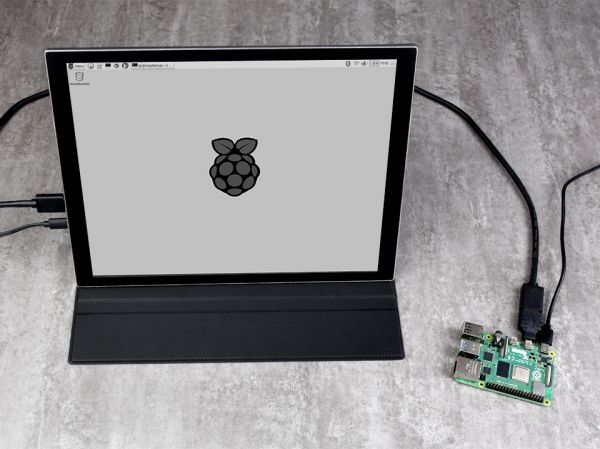Template: EINK DISP 103B RPI
Working With Raspberry Pi
Hardware Connection
- Please connect the matching 5V/3A power to the POWER port of the EINK monitor.
- Please connect the HDMI port of the EINK monitor to the HDMI port of the Raspberry Pi (an HDMI adapter is required in Pi4). The hardware connection is shown as below:
Software Setting
For the Raspberry/Ubuntu and Kali system of the Raspberry Pi.
When e-paper works with these Raspberry Pi systems, you need to set the resolution by yourselves, or else the display would be abnormal. When working with the Windows system of the PC, there will be normal.
Please download the latest image from the official raspberry pi website.
- Please download the compressed file to your PC, and extract the ".img" file.
- Connect the TF card to your PC, and use SDFormatter to format the TF card.
- Open Win32DiskImager, please select the system image prepared in step 1 and click "write" to program the system image
- After the programming is completed, open the config.txt file in the root directory of the TF card, add the following code at the end of config.txt, save and safely eject the TF card.
max_framebuffer_height=1404 max_usb_current=1 config_hdmi_boost=10 hdmi_group=2 hdmi_force_hotplug=1 hdmi_mode=87 hdmi_timings=1872 1 88 4 44 1404 1 8 2 6 0 0 0 45 0 131685000 13
- Insert the TF card into the Raspberry Pi. Power on the Raspberry Pi, and it will display normally after a few seconds.
Note 1: If you uses the Raspberry Pi 4, you also need to comment out dtoverlay=vc4-fkms-V3D.
Note 2: As the resolution of the Raspberry Pi changes during the boot process, it is normal for the Raspberry Pi to be abnormal a few seconds before booting.
Optimization
When using the e-ink screen display, due to the limitation of its own display principle, the existence of ghost shadows is unavoidable. Reasonable optimization of the interface can reduce the ghost shadows as much as possible and optimize the display effect.
Optimize The Interface
In order to keep the ghosting as less as possible, it is generally recommended to set the display effect of black characters on a white background.
- Open the menu->Preferences->Appearance Settings, select "No image" in the Layout option of the Desktop option page, choose "white" in the Colour, and choose "black" in the Text Colour. Click OK to save.
- Open Terminal->Edit->Preferences, select white in Background and black in Foreground, and click OK to save.
Disable sleep mode
The display principle of EINK display and LCD display is different. When the EINK display is in use, if the data of the two frames before and after the image signal are the same, EINK will not do any processing. An LCD monitor, on the other hand, will continue to refresh the image, even if the same static image is displayed for a long time. Most systems have set the standby mode by default, and this mode is more to make LCD monitors and CRT monitors have a longer service life, but there is no such problem with EINK monitors. So you can directly set the system to not sleep. The setting method is as follows: Open lightdm.conf.
sudo nano /etc/lightdm/lightdm.conf
Modify lightdm.conf to find the 'xserver-command' under the [SeatDefaults] section, uncomment it, and modify it as follows:
#xserver-command=X
Change to:
xserver-command=X -s 0 -dpms
- -s # set screen saver not enabled.
- dpms turn off power saving management.
Reboot:
sudo reboot
